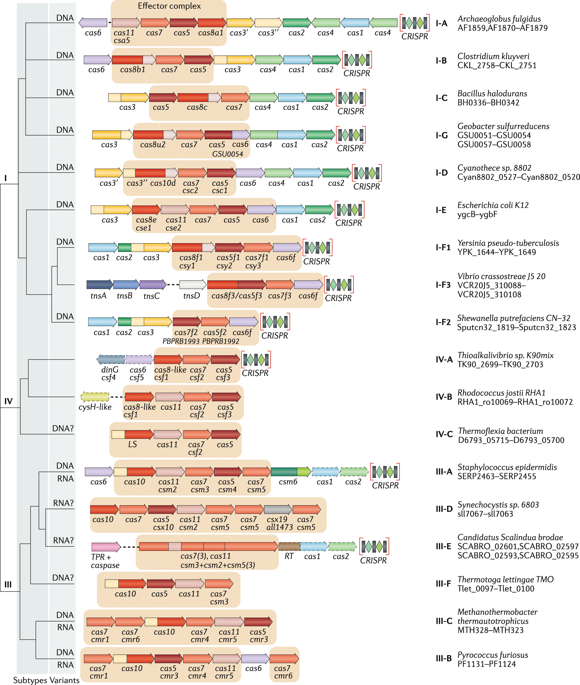当前位置:
X-MOL 学术
›
Nat. Rev. Microbiol.
›
论文详情
Our official English website, www.x-mol.net, welcomes your feedback! (Note: you will need to create a separate account there.)
Evolutionary classification of CRISPR-Cas systems: a burst of class 2 and derived variants.
Nature Reviews Microbiology ( IF 88.1 ) Pub Date : 2019-12-19 , DOI: 10.1038/s41579-019-0299-x Kira S Makarova 1 , Yuri I Wolf 1 , Jaime Iranzo 1 , Sergey A Shmakov 1 , Omer S Alkhnbashi 2 , Stan J J Brouns 3 , Emmanuelle Charpentier 4 , David Cheng 5 , Daniel H Haft 1 , Philippe Horvath 6 , Sylvain Moineau 7 , Francisco J M Mojica 8 , David Scott 5 , Shiraz A Shah 9 , Virginijus Siksnys 10 , Michael P Terns 11 , Česlovas Venclovas 10 , Malcolm F White 12 , Alexander F Yakunin 13, 14 , Winston Yan 5 , Feng Zhang 15, 16, 17, 18 , Roger A Garrett 19 , Rolf Backofen 2, 20 , John van der Oost 21 , Rodolphe Barrangou 22 , Eugene V Koonin 1
Nature Reviews Microbiology ( IF 88.1 ) Pub Date : 2019-12-19 , DOI: 10.1038/s41579-019-0299-x Kira S Makarova 1 , Yuri I Wolf 1 , Jaime Iranzo 1 , Sergey A Shmakov 1 , Omer S Alkhnbashi 2 , Stan J J Brouns 3 , Emmanuelle Charpentier 4 , David Cheng 5 , Daniel H Haft 1 , Philippe Horvath 6 , Sylvain Moineau 7 , Francisco J M Mojica 8 , David Scott 5 , Shiraz A Shah 9 , Virginijus Siksnys 10 , Michael P Terns 11 , Česlovas Venclovas 10 , Malcolm F White 12 , Alexander F Yakunin 13, 14 , Winston Yan 5 , Feng Zhang 15, 16, 17, 18 , Roger A Garrett 19 , Rolf Backofen 2, 20 , John van der Oost 21 , Rodolphe Barrangou 22 , Eugene V Koonin 1
Affiliation

|
The number and diversity of known CRISPR-Cas systems have substantially increased in recent years. Here, we provide an updated evolutionary classification of CRISPR-Cas systems and cas genes, with an emphasis on the major developments that have occurred since the publication of the latest classification, in 2015. The new classification includes 2 classes, 6 types and 33 subtypes, compared with 5 types and 16 subtypes in 2015. A key development is the ongoing discovery of multiple, novel class 2 CRISPR-Cas systems, which now include 3 types and 17 subtypes. A second major novelty is the discovery of numerous derived CRISPR-Cas variants, often associated with mobile genetic elements that lack the nucleases required for interference. Some of these variants are involved in RNA-guided transposition, whereas others are predicted to perform functions distinct from adaptive immunity that remain to be characterized experimentally. The third highlight is the discovery of numerous families of ancillary CRISPR-linked genes, often implicated in signal transduction. Together, these findings substantially clarify the functional diversity and evolutionary history of CRISPR-Cas.
中文翻译:

CRISPR-Cas 系统的进化分类:2 类和衍生变体的爆发。
近年来,已知 CRISPR-Cas 系统的数量和多样性大幅增加。在这里,我们提供了 CRISPR-Cas 系统和 cas 基因的最新进化分类,重点介绍了自 2015 年最新分类发布以来发生的主要发展。新分类包括 2 个类别、6 个类型和 33 个亚型,与 2015 年的 5 种类型和 16 种亚型相比。一个关键的发展是不断发现多种新型 2 类 CRISPR-Cas 系统,现在包括 3 种类型和 17 种亚型。第二个主要创新是发现了许多衍生的 CRISPR-Cas 变体,这些变体通常与缺乏干扰所需核酸酶的移动遗传元件相关。其中一些变体参与了 RNA 引导的转座,而其他人预计将执行与适应性免疫不同的功能,这些功能仍有待实验表征。第三个亮点是发现了许多与 CRISPR 相关的辅助基因家族,这些基因通常与信号转导有关。总之,这些发现基本上阐明了 CRISPR-Cas 的功能多样性和进化历史。
更新日期:2019-12-20
中文翻译:

CRISPR-Cas 系统的进化分类:2 类和衍生变体的爆发。
近年来,已知 CRISPR-Cas 系统的数量和多样性大幅增加。在这里,我们提供了 CRISPR-Cas 系统和 cas 基因的最新进化分类,重点介绍了自 2015 年最新分类发布以来发生的主要发展。新分类包括 2 个类别、6 个类型和 33 个亚型,与 2015 年的 5 种类型和 16 种亚型相比。一个关键的发展是不断发现多种新型 2 类 CRISPR-Cas 系统,现在包括 3 种类型和 17 种亚型。第二个主要创新是发现了许多衍生的 CRISPR-Cas 变体,这些变体通常与缺乏干扰所需核酸酶的移动遗传元件相关。其中一些变体参与了 RNA 引导的转座,而其他人预计将执行与适应性免疫不同的功能,这些功能仍有待实验表征。第三个亮点是发现了许多与 CRISPR 相关的辅助基因家族,这些基因通常与信号转导有关。总之,这些发现基本上阐明了 CRISPR-Cas 的功能多样性和进化历史。


























 京公网安备 11010802027423号
京公网安备 11010802027423号